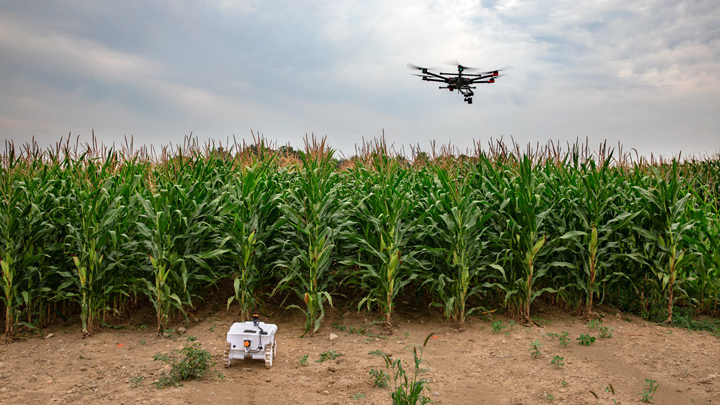Plant breeding has been going on for 10,000 years but technology –unmanned aerial vehicles (UAVs), robots, artificial intelligence (AI) and machine learning –is revolutionizing the practice.
 Plant Breeders Tap Robots, Drones and AI to Feed the World
Plant Breeders Tap Robots, Drones and AI to Feed the World

Lindsey Hadlock | Musgrave Research Farm
Mike Gore, Ph.D. ’09, hears the clock ticking. And while it’s not an alarm clock, it’s part of what gets him going every day.
Gore, associate professor of molecular breeding and genetics for nutritional quality, Liberty Hyde Bailey professor and international professor of plant breeding and genetics, conducts research at the intersection of several disciplines. His lab uses quantitative genetics, genomics, analytical chemistry and remote sensing to explore the genetic basis of trait variation in crops such as corn, oat and cassava.
Plant breeding has been going on for 10,000 years, he said, but technology –unmanned aerial vehicles (UAVs), robots, artificial intelligence (AI) and machine learning –is revolutionizing the practice.
“One role that we plant breeders can play is to learn how to integrate these cutting-edge technologies into research programs,” he said, “so that we can more efficiently and effectively select [plant variations] for the high-yielding, or highly nutritious, cultivar that can help feed the world’s population.”
Feeding the world’s population: It’s a huge challenge for plant breeders, he said, as well as researchers in other disciplines. Cornell is addressing it with the Cornell Initiative for Digital Agriculture(CIDA), which is leveraging digital innovations in agriculture to improve the sustainability, profitability, resiliency and efficiency of the world’s food systems. Gore is in the CIDA leadership group.
Currently at around 7.6 billion people, Earth’s population is expected to reach around 10 billion by 2050. How will we feed all those people in an efficient and sustainable way?
Gore admits that, although there’s still time to come up with viable solutions, he’s feeling the urgency.“
I think all plant scientists do,” Gore said. “We all sharethat passion, but we definitely hear that clock ticking. Let’s hope it’s not a timebomb.”

Gore’s lab uses “rapid phenotyping” –the ability to non-destructively measure a plant’s morphological, physiological, and biochemical properties in real time repeatedly page 2–over the course of a growing season, as opposed to waiting until harvest. That could help reduce the time it takes to develop crop varieties that are optimal for a particular region or climate.
“With these new technologies, we’re able to do phenotyping every day, every week, every month, to know how the plant is responding to the environment over whole growing seasons,” Gore said.
Among other crops, Gore’s lab focuses on corn –including corn grown in upstate New York –and the development of variations that are best suited to the short growing season and weather conditions. His lab employs camera-wielding UAVs –drones –and four-wheeled robots to perform real-time diagnostics of scores of corn varieties at the Musgrave Research Farm in Aurora, New York, about 24 miles north of campus.
This past summer, his shared 3-acre cornfield contained approximately 800 highly diverse hybrids, each in two-row mini-plots, from which his team will try to identify the best varieties for growing in the upstate region.
Gore’s team –in collaboration with the lab ofEd Buckler, adjunct professor of plant breeding and genetics –is developing AI for the autonomous vehicles that can count individual plants, measure plant height and check individual leaves for disease, among other tasks. And he can perform diagnostics on the plant at any point in its growth process.
“It’s like knowing a baseball player’s batting average in July, as opposed to just at the end of the season,” he said. “We’re trying to identify the key plant developmental stage that you can do the phenotyping on, so that it could be predictive of yield at the end of the season.
“If you had that capability,” he said, “then you’d know what plants to cross-breed before the pollen’s even been shed.”
By using technology to detect key traits in midseason, Gore said, he can perhaps develop more precise breeding methods –and shorten the breeding timeline “from six to eight years, to maybe four or five” as the technologies are developed.
He envisions a day when a robot or drone can not only facilitate rapid phenotyping, but also detect fungal diseases or weeds and immediately dispense a fungicide or page 3–herbicide in a precise dose, at just the right coordinate in the field. And while there will always be humans on a farm, Gore thinks a role-reversal could be in the offing.
“If we can train the robots, perhaps someday the robots will be training us to do very precise plant breeding,” he said. “We have more than 800 highly diverse hybrids in this field [at Musgrave]. Which one is the best for growing here, and why? Those are the questions we’re trying to answer. ... We’re trying to closely model the biological reality of a plant. I would argue that, over time, robots can probably do it even better than human beings. That’s what we’re kind of on the cusp of right now.”
Developing a corn variety that’s best suited for upstate New York is one of many challenges Gore and researchers like him are tackling as thespecter of feeding 10 billion people looms.
“All of these tools are going to be important for food and nutrition security,” he said. “How do we figure out how to use these technologies for crops such as cassava, rice, maize, wheat that all of these developing nations are relying on for nourishment?
“How do we turn the engine of evolution faster in plant breeding?” he asked. “We have to totally change the paradigm that we’ve been in for the past 10,000 years.”
The content & opinions in this article are the author’s and do not necessarily represent the views of AgriTechTomorrow
Comments (0)
This post does not have any comments. Be the first to leave a comment below.
Featured Product

